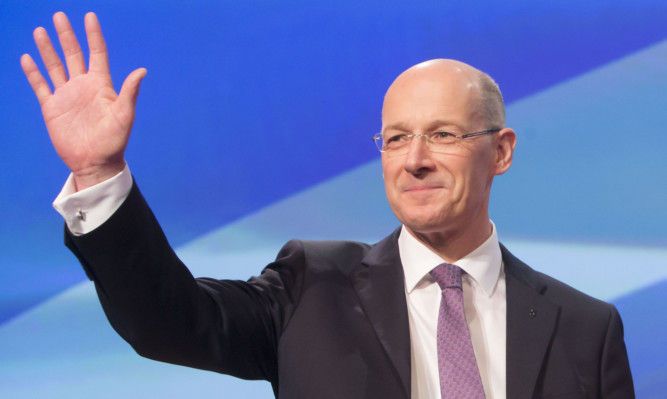
The Scottish National Party will consider putting plans for another independence referendum in its election manifesto for Holyrood next year, Deputy First Minister John Swinney has said.
Mr Swinney said the SNP’s Scottish landslide victory in the general election did not give it a mandate to hold another referendum.
He reiterated First Minister Nicola Sturgeon’s assurance that another referendum can only be sanctioned by a vote for a party that has proposed one in its manifesto.
When pressed on whether the SNP will propose a re-run next year, he said: “That is an issue that the party will determine and consider in the run-up to the 2016 election.”
Ms Sturgeon will urge Prime Minister David Cameron to hand Scotland more powers beyond those recommended by the cross-party Smith Commission on Devolution when they meet in Edinburgh today.
Former Scottish secretary Alistair Carmichael has accused Ms Sturgeon of setting out unreasonable demands that she knows will be refused, to drive a wedge between Holyrood and Westminster and justify proposals for another referendum.
Ms Sturgeon has described Westminster’s initial devolution offer as “a strong starting point” but reiterated her desire to secure “full fiscal responsibility” for Scotland.
And she has urged the Prime Minister to “demonstrate that Westminster does listen” to Scotland or risk swaying public opinion towards another independence referendum.
Speaking on BBC Radio Scotland’s Good Morning Scotland programme, Mr Swinney said: “We don’t have a mandate for a second referendum.
“We didn’t seek one at the UK general election, and I don’t think we could have made it any clearer that there was nothing – absolutely nothing – about the outcome in the UK general election.
“We have set out the process by which Scotland could have a referendum on independence, and that is that a political party – the Scottish National Party – would have to put that in our manifesto in a Scottish Parliament election.
“That is an issue that the party will determine and consider in the run-up to the 2016 election.
“We said if there was to be a second referendum, that would have to be put into the manifesto of the party and it would have to be supported by the public.
“Now there is nothing – absolutely nothing – that I can claim from the election last Thursday that gives us any right to hold a second referendum on the independence question and we are not planning a second independence referendum.
“We respect the outcome of the referendum last September and what we are focused on is making sure that the electoral decisions of the people of Scotland last Thursday, which were to substantially support the Scottish National Party in the election, are used to secure the additional powers and responsibilities that we said to the people of Scotland that we were arguing for in the election.”
Mr Swinney also described as “scandalous” Mr Cameron’s appointment of Andrew Dunlop, an adviser to Margaret Thatcher when the poll tax was introduced in 1989, as a junior minister in the Scotland Office following his elevation to the House of Lords.
“The Conservatives have just commanded their worst level of support in Scotland for over 100 years,” he told BBC Radio 4’s Today programme.
“They have one MP in Scotland and what the Prime Minister has done is to appoint the architect of the poll tax to the House of Lords and to make him a minister in the United Kingdom Government.
“If that is what David Cameron means by governing by respect, it’s a very, very odd definition of the term indeed.”
Mr Carmichael told Today: “Be quite clear about what Nicola Sturgeon is about here.
“What she is wanting is to make a series of demands which she knows will be refused which will then drive that little wedge that bit further between Westminster and Holyrood and which will justify her then in going to the people of Scotland next year in her manifesto in the Scottish Parliament elections with a proposal for a second referendum.
“That’s what this is all about.”

Enjoy the convenience of having The Sunday Post delivered as a digital ePaper straight to your smartphone, tablet or computer.
Subscribe for only £5.49 a month and enjoy all the benefits of the printed paper as a digital replica.
Subscribe